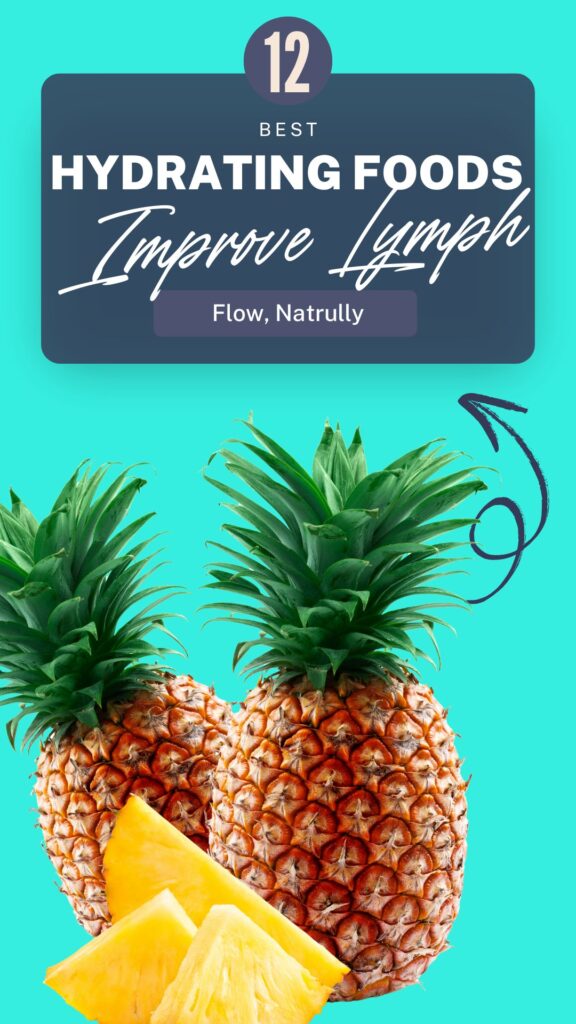This post contains affiliate links. I may earn a small commission if you buy through these links, at no extra cost to you.
Did you know that your body carries nearly 2–3 liters of lymph fluid daily—a clear liquid that helps remove toxins, waste, and other unwanted materials?
Unlike blood, which has the heart to pump it, lymph relies heavily on hydration, movement, and nutrition to circulate properly. Poor lymph flow can lead to swelling, fatigue, sluggish immunity, and even skin issues.
Here’s the good news: certain hydrating foods can naturally improve lymphatic circulation. These foods not only quench your thirst but also provide electrolytes, antioxidants, and enzymes that keep your lymph moving efficiently.
In this guide, we’ll cover:
- The 10 best hydrating foods that boost lymph flow.
- The best ways to eat or use them for maximum benefit.
- Who should eat or avoid them.
- Storage and buying tips to keep them fresh.
- Do’s & don’ts so you don’t lose their health benefits.
- Possible side effects (because too much of a good thing can sometimes backfire).
Let’s dive into the foods that can keep your lymphatic system clear, your body energized, and your skin glowing.

Table of Contents

10 Best Hydrating Foods To Eat
1. Cucumbers
Cucumbers are more than 95% water, making them one of the most hydrating vegetables you can eat. They’re rich in silica, which supports connective tissue and helps reduce water retention.
Best Ways to Eat or Use It
- Slice into salads.
- Blend into smoothies with mint.
- Infuse cucumber slices in water for a refreshing detox drink.
Who Should Eat / Avoid
- Good for: weight-loss seekers, athletes, and people struggling with bloating.
- Avoid/Limit if: you have sensitive digestion; some people experience burping or mild gas.
Storage & Buying Tips
- Choose firm cucumbers with dark green skin.
- Store in the fridge wrapped in a paper towel inside a bag to retain crispness.
Do’s & Don’ts
✅ Do: Eat raw for best hydration.
❌ Don’t: Peel them too often—you’ll lose fiber and antioxidants.
Possible Side Effects
Excessive cucumber water may lead to mild stomach upset in some people due to natural cucurbitacin compounds.
2. Watermelon
Myth buster: many people think watermelon is just “sugar water.” In reality, it’s packed with electrolytes, vitamins A and C, and lycopene, a powerful antioxidant that supports lymphatic detox.
Best Ways to Eat or Use It
- Fresh slices as snacks.
- Watermelon juice with a squeeze of lime.
- Combine with feta and mint for a refreshing salad.
Who Should Eat / Avoid
- Good for: hot climates, athletes, and those prone to dehydration.
- Avoid/Limit if: diabetic patients (due to natural sugars—moderation is key).
Storage & Buying Tips
- Choose a heavy watermelon with a yellow spot (a sign of ripeness).
- Store uncut at room temperature; refrigerate after cutting.
Do’s & Don’ts
✅ Do: Eat chilled in summer for hydration.
❌ Don’t: Leave cut watermelon outside—it spoils quickly.
Possible Side Effects
Eating too much may cause bloating or loose stools because of its high water and fiber content.
3. Celery
Celery is often underestimated, but it’s full of water, potassium, and sodium, which help regulate fluid balance and encourage lymph movement.
Best Ways to Eat or Use It
- Add to soups or stir-fries.
- Blend into green juices with cucumber and apple.
- Use celery sticks as a crunchy snack with hummus.
Who Should Eat / Avoid
- Good for: people with high blood pressure, detox diets.
- Avoid/Limit if: you’re allergic to celery (a common but overlooked allergy).
Storage & Buying Tips
- Look for firm, crisp stalks.
- Store wrapped in foil in the fridge to retain freshness.
Do’s & Don’ts
✅ Do: Eat raw for maximum hydration.
❌ Don’t: Overcook—it loses water content quickly.
Possible Side Effects
May cause digestive upset in high amounts due to fiber.
4. Pineapple
Pineapple contains bromelain, an enzyme that reduces inflammation and supports better lymphatic drainage.
Best Ways to Eat or Use It
- Fresh pineapple chunks.
- Pineapple smoothie with coconut water.
- Pineapple salsa with lime and chili.
Who Should Eat / Avoid
- Good for: people with inflammation, sinus congestion, or sluggish digestion.
- Avoid/Limit if: you have acid reflux—pineapple can trigger symptoms.
Storage & Buying Tips
- Choose pineapples with a sweet aroma at the base.
- Store whole at room temp; refrigerate once cut.
Do’s & Don’ts
✅ Do: Pair with protein (chicken/fish) for better digestion.
❌ Don’t: Eat unripe pineapple—it can irritate the throat.
Possible Side Effects
Excess bromelain may thin the blood slightly—consult a doctor if on blood thinners.
5. Leafy Greens (Spinach & Kale)
Leafy greens are loaded with chlorophyll, magnesium, and antioxidants that improve circulation and detox. Their water content helps hydrate and keep lymph flowing smoothly.
Best Ways to Eat or Use It
- Fresh in salads.
- Lightly sautéed with garlic.
- Green smoothies with banana and water.
Who Should Eat / Avoid
- Good for: weight loss, athletes, those with weak immunity.
- Avoid/Limit if: you have kidney stones (oxalates may worsen them).
Storage & Buying Tips
- Choose vibrant, crisp leaves.
- Store in airtight bags with a paper towel to absorb moisture.
Do’s & Don’ts
✅ Do: Rotate greens to avoid excess oxalates.
❌ Don’t: Let them wilt before eating—nutrient loss occurs quickly.
Possible Side Effects
Too much raw spinach can interfere with calcium absorption.
6. Citrus Fruits (Oranges, Grapefruits, Lemons)
Citrus fruits are hydrating and packed with vitamin C, which boosts immunity and supports lymphatic cleansing.
Best Ways to Eat or Use It
- Fresh orange slices.
- Grapefruit juice in the morning.
- Lemon water throughout the day.
Who Should Eat / Avoid
- Good for: people with low immunity, skin issues, fatigue.
- Avoid/Limit if: you have citrus allergies or acid reflux.
Storage & Buying Tips
- Choose firm, brightly colored fruits.
- Store at room temp for a week, or refrigerate for longer freshness.
Do’s & Don’ts
✅ Do: Drink lemon water in the morning for hydration.
❌ Don’t: Add too much sugar to juices—it negates the benefits.
Possible Side Effects
Citrus can erode tooth enamel—rinse your mouth after consumption.
7. Berries (Blueberries, Strawberries, Raspberries)
Fun fact: Berries contain quercetin, a plant compound that supports blood and lymph flow by reducing inflammation.
Best Ways to Eat or Use It
- Fresh in yogurt or oatmeal.
- Frozen berries in smoothies.
- Berry salads with a drizzle of honey.
Who Should Eat / Avoid
- Good for: brain health, athletes, people on detox diets.
- Avoid/Limit if: you have berry allergies.
Storage & Buying Tips
- Buy plump, firm berries with no mold.
- Store in the fridge and wash just before eating.
Do’s & Don’ts
✅ Do: Eat a mix of different berries for variety.
❌ Don’t: Leave them at room temperature—they spoil quickly.
Possible Side Effects
Too many berries may cause loose stools due to fiber content.
8. Coconut Water
Coconut water is a natural electrolyte drink, rich in potassium, that supports hydration and smooth lymphatic flow.
Best Ways to Eat or Use It
- Drink fresh coconut water.
- Add to smoothies as a liquid base.
- Use in homemade popsicles.
Who Should Eat / Avoid
- Good for: athletes, hot climates, people prone to dehydration.
- Avoid/Limit if: you have kidney disease (high potassium may be harmful).
Storage & Buying Tips
- Opt for fresh coconuts if available.
- Store packaged coconut water in the fridge once opened.
Do’s & Don’ts
✅ Do: Choose natural, unsweetened coconut water.
❌ Don’t: Confuse it with coconut milk (much higher in fat).
Possible Side Effects
Excessive coconut water may lower blood pressure too much.
9. Zucchini
Zucchini is 94% water and contains potassium, which helps balance fluids and reduce lymph stagnation.
Best Ways to Eat or Use It
- Spiralize into zucchini noodles.
- Add to soups and stews.
- Grill or roast lightly.
Who Should Eat / Avoid
- Good for: weight management, detox diets.
- Avoid/Limit if: you have a sensitive gut (it may cause mild bloating).
Storage & Buying Tips
- Choose firm zucchinis with shiny skin.
- Store in a perforated bag in the fridge.
Do’s & Don’ts
✅ Do: Eat with skin on for fiber.
❌ Don’t: Overcook—it turns mushy and loses nutrients.
Possible Side Effects
Rare, but raw zucchini may contain bitter compounds if harvested immaturely.
10. Tomatoes
Tomatoes are hydrating and rich in lycopene, which helps reduce inflammation and supports lymphatic detox.
Best Ways to Eat or Use It
- Fresh in salads.
- Tomato juice with a pinch of salt.
- Cooked with olive oil to enhance lycopene absorption.
Who Should Eat / Avoid
- Good for: heart health, detox diets.
- Avoid/Limit if: you have acid reflux or nightshade sensitivity.
Storage & Buying Tips
- Buy firm, brightly red tomatoes.
- Store at room temperature, not in the fridge (cold dulls flavor).
Do’s & Don’ts
✅ Do: Pair with olive oil for maximum lycopene absorption.
❌ Don’t: Eat unripe green tomatoes—they can be mildly toxic.
Possible Side Effects
Too many tomatoes may cause acid reflux in sensitive individuals.
Conclusion
Hydration is not only about drinking water—it’s also about eating the right foods that support your body’s natural cleansing systems.
From cucumbers and watermelon to leafy greens and citrus fruits, these hydrating foods provide the perfect blend of water, electrolytes, and antioxidants to keep your lymph flowing smoothly.
Incorporating them into your daily meals can reduce bloating, improve energy, enhance skin health, and strengthen immunity.
Try adding at least one of these foods to your next meal and notice how much lighter and energized you feel. Which of these hydrating foods is your favorite? Share your go-to recipe in the comments below!
Frequently Asked Questions (FAQs)
Can hydrating foods really improve lymph flow?
Yes. Hydrating foods help thin and move lymph fluid more efficiently because they provide water, electrolytes, and anti-inflammatory compounds. Unlike blood, lymph has no pump, so hydration and diet play a direct role in circulation.
How much water-rich food should I eat daily for better lymph flow?
Aim to include at least 3–4 servings of hydrating fruits and vegetables (like cucumbers, watermelon, citrus, or leafy greens) along with enough water intake to maintain optimal hydration.
Are these foods a replacement for drinking water?
No. While hydrating foods contribute to fluid intake, they complement but do not replace plain water. You should still drink 6–8 glasses of water per day.
Can too many hydrating foods cause side effects?
Yes, in some cases. Overeating watermelon, berries, or citrus may cause bloating, loose stools, or acid reflux. Moderation is key.
Which is better for lymph flow—raw or cooked foods?
Raw foods like cucumber, celery, and watermelon provide maximum hydration, while lightly cooked tomatoes or leafy greens release certain antioxidants better. A balance of raw and cooked options works best.
Can children and pregnant women eat these hydrating foods?
Absolutely. Most hydrating foods like cucumber, watermelon, and leafy greens are safe and beneficial. However, pregnant women should consult their doctor if they have conditions like gestational diabetes (due to fruit sugar intake).
How soon can I notice benefits from adding hydrating foods?
Many people feel improvements in energy, digestion, and reduced bloating within a week, especially when combined with exercise and proper hydration.
Do these foods help with skin health too?
Yes. A well-functioning lymphatic system clears toxins that often show up as acne, puffiness, or dull skin. Hydrating foods also add antioxidants that promote glowing, youthful skin.
What’s the best way to start adding these foods to my diet?
Start simple—add cucumber slices to water, eat citrus fruit in the morning, or blend a green smoothie with leafy greens and pineapple. Small daily changes make the biggest difference over time.










